OCZ Vertex 3 (240GB) Review
by Anand Lal Shimpi on May 6, 2011 1:50 AM ESTRandom Read/Write Speed
The four corners of SSD performance are as follows: random read, random write, sequential read and sequential write speed. Random accesses are generally small in size, while sequential accesses tend to be larger and thus we have the four Iometer tests we use in all of our reviews.
Our first test writes 4KB in a completely random pattern over an 8GB space of the drive to simulate the sort of random access that you'd see on an OS drive (even this is more stressful than a normal desktop user would see). I perform three concurrent IOs and run the test for 3 minutes. The results reported are in average MB/s over the entire time. We use both standard pseudo randomly generated data for each write as well as fully random data to show you both the maximum and minimum performance offered by SandForce based drives in these tests. The average performance of SF drives will likely be somewhere in between the two values for each drive you see in the graphs. For an understanding of why this matters, read our original SandForce article.
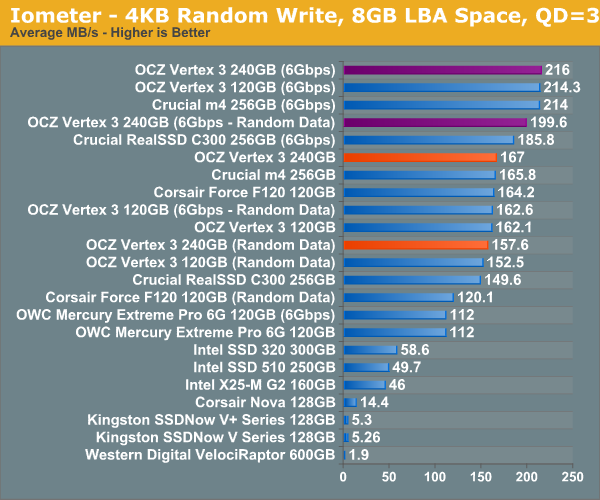
Many of you have asked for random write performance at higher queue depths. What I have below is our 4KB random write test performed at a queue depth of 32 instead of 3. While the vast majority of desktop usage models experience queue depths of 0 - 5, higher depths are possible in heavy I/O (and multi-user) workloads:
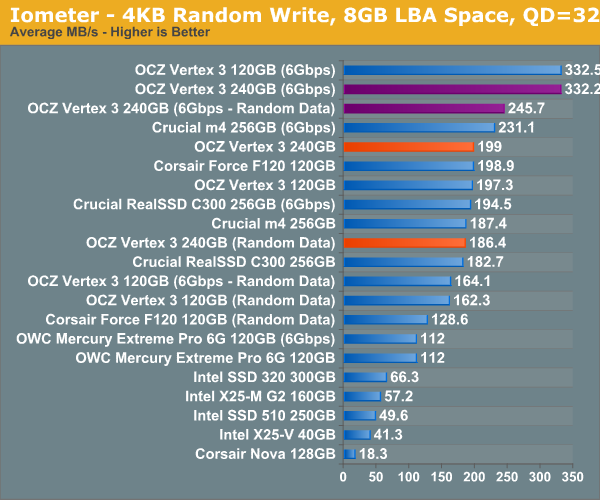
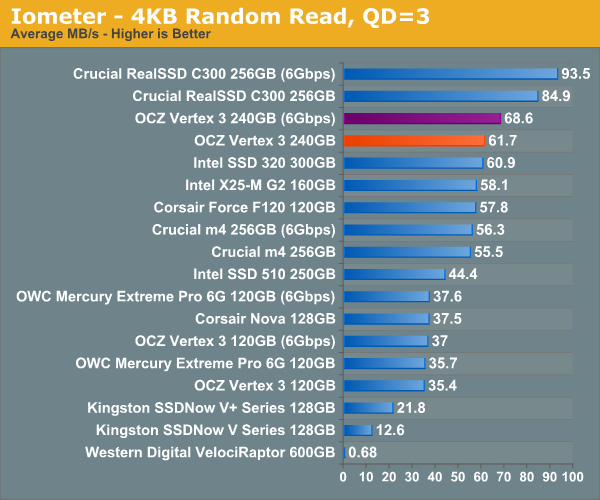
Sequential Read/Write Speed
To measure sequential performance I ran a 1 minute long 128KB sequential test over the entire span of the drive at a queue depth of 1. The results reported are in average MB/s over the entire test length.
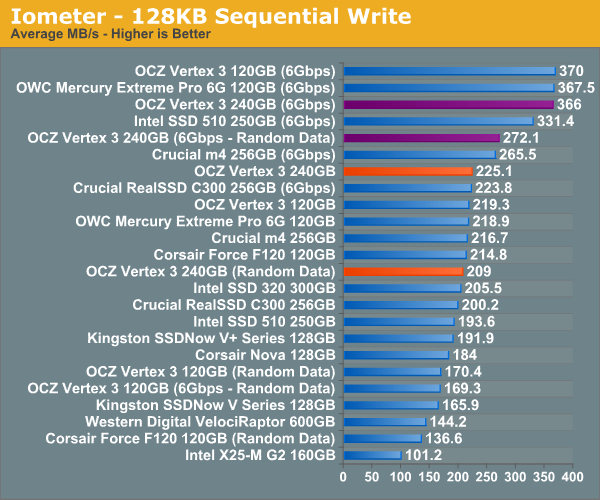
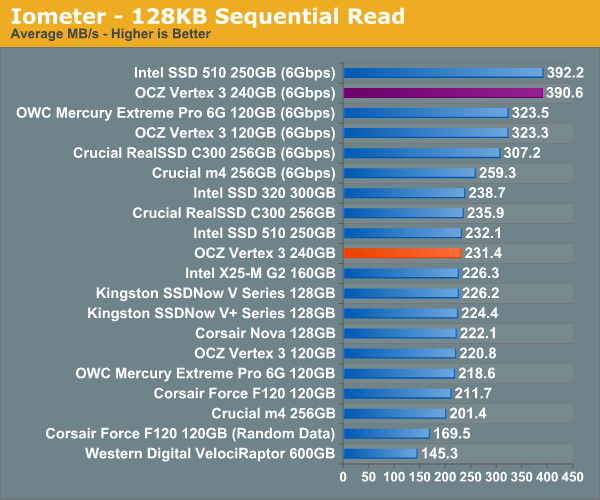










90 Comments
View All Comments
tech6 - Friday, May 6, 2011 - link
Thanks for another thorough review. I noticed that the Samsung 470 (and its OEM equivalent) are getting very popular. Any chance of a review?Anand Lal Shimpi - Friday, May 6, 2011 - link
I've been meaning to do a roundup focusing on 3Gbps drives and diving deeper on the 470, it's just a matter of finding the time. It's definitely on the list though.Take care,
Anand
darwinosx - Friday, May 6, 2011 - link
With Samsungs drive division having been sold to Seagate you have to wonder what happens to service and support of Samsung branded drives.TotalLamer - Friday, May 6, 2011 - link
...any chance the Vertex 3s won't spontaneously brick themselves whenever they damned well choose like the Vertex 2s did? Such horridly unreliable drives.No Intel, no care.
jmunjr - Friday, May 6, 2011 - link
A lot of ultraportable laptops use 7mm height drives. From what I ahve read the Vertex series are 9.5mm and cannot be easily modded to fit. The Crucial however have a space that can be easily removed(though it voids the warranty). Is really would be nice to have more SSD choices in the 7mm height option.jcompagner - Friday, May 6, 2011 - link
I think also a warning must be given, because they really don't work quite right out of the box with everything default.I have a Dell XPS17 (L702x) and the Vertex 3 240GB, and installing windows 7 (sp1) is quite hard. The default AHCI driver of windows really doesn't work with the Vertex 3. So yes you can install it in sata mode that kind of works but you want AHCI, And setting that after install is not that easy (you really have to make sure that the latest intel drivers are there and then tweak some registry setting)
Best thing to go around this is to use the Intel F6 driver right from the installer of Win7. That will help and then you can install it at once.
The thing is that OCZ sees this as a problem with drivers or the system, i completely don't agree with this, there are many complaining constantly on the forum because of this. And the intel drive that i also have never have these problems they install just fine. So it is really OCZ which should look into why they are not compatible.
Besides that after you have taken this hurdle you have ofcourse the LPM registry tweak you have to do to kill LPM mode. But this is not only a OCZ/Vertex problem also Crucial (C300) has this same problem. But again with the Intel SSD i haven't seen this problem also.
I just think that the Vertex doesn't behave completely correct on all the SATA commands that are out there. I really hope for them that they can fix that (they get a bit of bad name i know enough forums that really don't recommend OCZ because of all this)
But after all these install troubles i must say it is fast and works quite well.
I don't really like that now a MAXIOPS version is coming also for the 240GB! I am curious of how much faster that will be
One question: If the number of die's tells everything about the speeds, why is the 480GB then slower? (at least on paper)
Ammaross - Friday, May 6, 2011 - link
"One question: If the number of die's tells everything about the speeds, why is the 480GB then slower? (at least on paper) "You didn't read the interleaving example then. If 2 die per chip, and 2 chips per channel fill up 4 of the 5 theoretical "slots" in the 5-clock example, imagine what 4 dies per chip and 2 chips per channel does trying to cram/schedule 8 dies into 5 slots? Then think what happens if all requests are going to one or two die on the same package? It's just a matter of clogging the pipes or burning slots due to a package already processing a request. You can think of it like the 8x/8x/4x SLI/CF situation with P67 where that 3rd gfx card just doesn't help much at all due to being data-starved, or the overhead of SLI/CF in itself.
jcompagner - Saturday, May 7, 2011 - link
but still, why is it even slower and not the same speed as the 240GB then?darwinosx - Friday, May 6, 2011 - link
It seems from public comments on New Egg and elsewhere that there a lot of unhappy owners of tis drive. High failure rate and many people continue to comment on how poor OCZ's tech support is which is the opposite of what this review says.Lingyis - Friday, May 6, 2011 - link
is there something anandtech can test about reliability? i had 3 OCZ vertex from a few years ago and 2 of them had bad sectors after about 6 months of use. whatever time i saved on the SSD was more than wiped out by my time having to reinstall software, and possibly each time it has to run chkdsk related commands. i have been quite reluctant to use SSD since--i went with good ol' HDD in my new laptop and chkdsk has yet to reveal any errors.some time ago, i read on this site that the officially from intel, failure rates are something like 1.2% for non-Intel drives and 0.5% for intel drives? obviously, massive data is required to get these kind of statistics, but if you can figure out some way of testing reliability on these SSD, that'll be much more important to people like me as SSD is fast enough for most practical purposes. perhaps you can run these drives intensely over a period of 30 days (probably more) and see if any data corruption sets in. if there's a way to limit read/write to a certain region of the SSD than better obviously, but the controller i suppose might have a say in that.